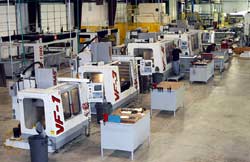US export curbs driving away business
06 Mar 2009
 The news that the US has stalled the supply of two gas turbines by General Electric Corp (GE) for India's new stealth warship 'Shivalik' should not really come as a big surprise, as America has a history of imposing last-minute sanctions on defence deals. The reason cited in this instance is that America is ''reviewing its defence relationship'' with several countries including India.
The news that the US has stalled the supply of two gas turbines by General Electric Corp (GE) for India's new stealth warship 'Shivalik' should not really come as a big surprise, as America has a history of imposing last-minute sanctions on defence deals. The reason cited in this instance is that America is ''reviewing its defence relationship'' with several countries including India.
The US could end up destroying its once booming space, defence and high tech industries through the sustained implementation of export control regulations. The so-called International Traffic in Arms Regulation (ITAR) managed by the US state department is proving to be an albatross around the neck of these enterprises.
The highly controversial ITAR was originally conceived as an instrument to prevent the proliferation of weapons by curbing the export of sensitive components of space technology, which by its very nature is a dual use system.
The technological subsystems developed for a launch vehicle meant to put a civilian satellite into orbit can with some modification be adopted for a long range missile capable of carrying a destructive warhead. Similarly, a satellite featuring an earth imaging system designed to monitor natural resources can also be deployed for surveillance and reconnaissance.
It would seem that the US wants to maintain its position as the unchallenged global defence leader by blocking the flow of technology to other countries. But the process is proving be counter-productive, as it has hit the profitability of American space hardware manufacturers hard in terms of business lost in a time of recession.
This in turn means that the American space industry has fewer funds to invest in research and development of new technologies which would strengthen the already dominant US position as the global technology powerhouse.
Significantly, during his election campaign, President Obama while referring to the successful Indian lunar probe Chandrayaan-1 and the spectacular Chinese space walk had expressed his concern over the US losing its dominance in the exploration of the final frontier.
President Obama had also pointed out that ITAR, with its exasperating and tedious rules, had inflicted huge damage on the once vibrant American space industry. He said ITAR has also put defence and associated high industrial ventures into a ''downward spiral''.
America is the loser  It was the stringent export regulation that spelled doom for the American supercomputer outfit Cray. The company was prevented from exporting its high end super computing machines on the ground that it could be diverted for military use, and had not option but to shut shop. This is just one example of what ITAR had done to the American high tech industry.
It was the stringent export regulation that spelled doom for the American supercomputer outfit Cray. The company was prevented from exporting its high end super computing machines on the ground that it could be diverted for military use, and had not option but to shut shop. This is just one example of what ITAR had done to the American high tech industry.
The American obsession with the possibility of sensitive technologies getting 'misused' has driven countries and organizations from across the world source their needs from elsewhere, where there are no such roadblocks.
A clear indication of the falling fortunes of the American space industry is that its share of commercial satellite production has plummeted to 50 per cent from more than 80 per cent in the first half of the last decade.
Countries are realising that they can buy whatever they need from elsewhere without going through the cumbersome, costly and complicated export regulation formalities. For instance, the Indian Space Research Organisation found easier to get the radiation hardened circuits for use in its INSAT satellite system from European sources.
Counter-productive strategy  On another plane, the American export restrictions have prompted countries like India and China to develop the hardware they need indigenously. To a large extent, the spirit of self reliance and confidence permeating the Indian and Chinese space efforts are a result of the American export control regime.
On another plane, the American export restrictions have prompted countries like India and China to develop the hardware they need indigenously. To a large extent, the spirit of self reliance and confidence permeating the Indian and Chinese space efforts are a result of the American export control regime.
Following the US sanctions after India's nuclear tests in 1998, ISRO was denied many of the critical components it need for its projects. However, ISRO managed to either develop the components it needed in-house or to get them from Western Europe.
The fully home-made cryogenic engine stage developed by ISRO, which will replace the Russian-supplied upper stage of the three-stage geosynchronous satellite launch vehicle (GSLV) during its flight planned for July 2009, can be attributed to America's technological bullying.
In the early 1990s, the US had coerced an emaciated and politically turbulent Russia into going back on its commitment of transferring the critical cryogenic engine technology to India. It now finds, no doubt to its dismay, that India's own cryogenic engine is ready to fly.
A spokesman of the Nevada-based Bigelow Aerospace has caustically pointed out, ''If the purpose of ITAR is to lose billions of dollars of business, ship jobs overseas and the Iranians and the Chinese get the same technology anyway, then mission accomplished.''
In fact, a survey of companies supplying space hardware carried out in 2007 by the US Air Force Research Laboratory showed that export control was the biggest barrier to accessing the overseas market.
Recently, P S Subramanyam, director of the Bangalore-based Aeronautical Development Agency (ADA), which has developed and light-tested India's light combat aircraft Tejas, made the point that the 1998 US sanctions was the best thing that could have happened to India's scientific efforts, as it spurred Indian scientists and engineers to develop these technologies and systems by themselves.
''When officials from BAE Systems, the third largest defence manufacturer in the world and part of the Eurojet consortium that makes the Typhoon fighter, came to see Tejas, they were amazed. For it has the latest configuration and it is completely indigenous,'' said Subramanyam.
US killing its space dominance  Despite US export restrictions, both India and China have made some ground in promoting their launch vehicles to put the satellite payloads of international customers into space.
Despite US export restrictions, both India and China have made some ground in promoting their launch vehicles to put the satellite payloads of international customers into space.
The American policy that a satellite built in USA or a satellite carrying US made components cannot be launched from countries like India and China has contributed in a big way to the declining orders for American satellite manufacturing outfits; Indian and Chinese space vehicles are far more cost effective than their American and European counterparts.
Developed countries too have been irritated by IRTA sanctions. The leading European space technology outfit Thales Alenia has made it clear that it would build spacecraft without any American hardware or components. Similarly, the European Space Agency (ESA) has decided to promote the production of many components it needs in Europe, and build ''ITAR Free'' launch vehicles and satellites.
In particular, the cost and delay involved in importing high tech components from the US continues to drive away global customers from approaching American companies. Even for the American companies keen on exporting space related components and hardware, it is a troublesome and costly procedure to go through ITAR formalities.
The progressive decline in the fortunes of the American space industry as a result of zealous application of export control act could result in the termination of many product lines that have a limited domestic demand. This could in the long run force the US itself to source components required for its space programme from outside the country, spelling the death of its dominance in space exploration.
Unreliable defence partner And of course, the US track record in dealing with the export of defence hardware and technology has made it a notoriously unreliable defence partner. The US insistence on the End User Certification agreement has been particularly galling to buyers of the American defence hardware.
And of course, the US track record in dealing with the export of defence hardware and technology has made it a notoriously unreliable defence partner. The US insistence on the End User Certification agreement has been particularly galling to buyers of the American defence hardware.
India has already told the US, which aims to replace Russia as the world's largest supplier of defence equipment, that the annual physical verification of the defence hardware, which has already been purchased at a great cost, should end.
For instance, as per the existing US defence trade regulations, three jets bought from Boeing to fly Indian leaders would be annually inspected by the American officials. New Delhi considers this a clear infringement of national sovereignty.
In fact, the Comptroller and Auditor General (CAG) in his report to the Indian Parliament had come down heavily on the Ministry of Defence for agreeing to the end user verification while buying the US warship 'Trenton' renamed INS Jalashwa.
There is also every indication that India would succumb to US pressure for the end user verification agreement in the supply of eight P-81 long range maritime reconnaissance aircraft from Boeing and six C-130 J transport helicopters from Lockheed Martin.
Both Boeing and Lockheed are in the race for the 126 medium, multi role combat aircraft for the Indian Air Force. But as things stand now, the US companies stand little chance as its government does not seem inclined to doing away with this clause covering arms purchases.
Similarly, the restrictions on the resale of US defence hardware could prove a big impediment in the way of American emerging as a favoured defence partner of India. Boeing vice-president of international strategy for integrated defence systems business development Jeffrey Kohler says, ''There will be a serious blow to the relationships and obviously, it would be virtually impossible to US defence companies to walk with the Indians.''
The much-hyped Indo-US civilian nuclear agreement has so far not helped matters in smoothening Indo-US defence ties. Nonetheless, Ravi Vohra, director of the New Delhi-based National Maritime Foundation, believes that in its own interest, the US will take steps to remove the irritants in the way of defence hardware export. But then it is always difficult to read the mind of the American bureaucratic and political set-up.































